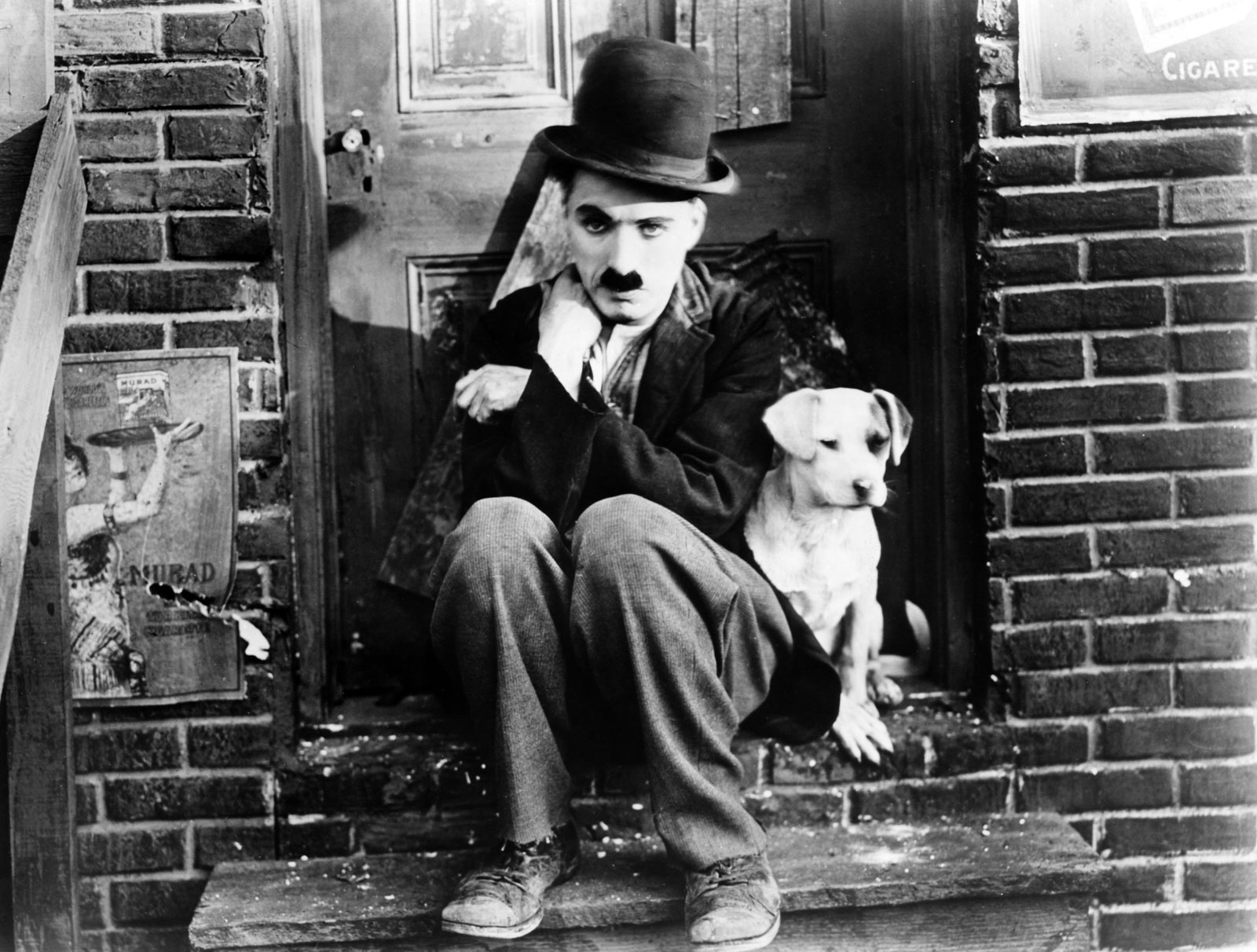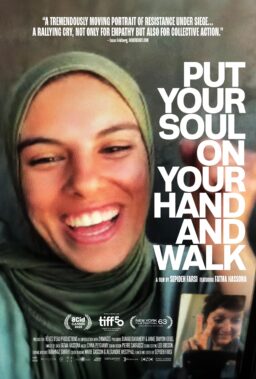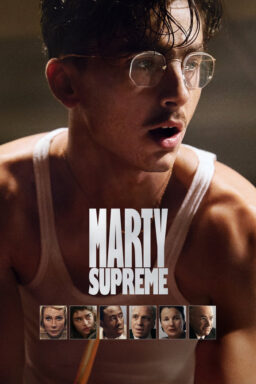Charlie Chaplin’s “The Tramp” was released to the public through Essanay Studios on April 12th, 1915, 100 years ago this weekend. This short film was a milestone for both Chaplin and his screen character, a tramp he called “the little fellow,” a bum, a hobo knocked around by life who does some knocking around himself. Chaplin’s Tramp is a homeless person most of the time, sleeping where he can, sometimes indoors and sometimes outdoors, taking work where he can get it. He has an eye for ladies, as Chaplin himself did, but very little to recommend him to their company, unlike Chaplin himself. He has to learn to smile though his heart is aching, and if he doesn’t feel like just smiling he is quick-footed enough to give a larger man a kick in the hind end and move away before there can be any retaliation, but life and the laws of slapstick physics will retaliate on Chaplin’s Tramp soon enough.
In 1914, Chaplin made 34 shorts and one feature at Mack Sennett’s Keystone Studios where he refined his comic character through trial and error, so that you can see him working out who he is as a screen performer before your eyes. A century later, that process is still stimulating and it can easily be seen online since most of these shorts are now in the public domain. Chaplin has been much written about in the 100 years since he first captured the attention of the public, but his career is so jam-packed with messy attitudes and impulses that it still stands as a shifting, fresh body of work to marvel at and get lost in.
Chaplin was born into extreme poverty in London in 1889. His parents were both music hall performers, but his father succumbed early to drink and his mother lost her singing voice and declined into mental instability exacerbated by malnutrition. At the age of five, Chaplin got his first lesson in dealing with an audience. His mother had gotten an engagement at a canteen in Aldershot, and while she was on stage her singing voice faltered. The audience, made up mostly of soldiers, began to jeer at her until she was forced to leave the stage. Five-year-old Charlie, prodded by the manager, went on in her stead and did a comic song he knew. The hostile audience came round for him, especially when he did an imitation of one of the songs his mother had been trying to sing, and they threw money on the stage. Already calculating, toddler Charlie made sure to pick up all the money before going on any further with his singing, a protective impulse that got him even bigger laughs. This was a defining lesson for him in what it took to tame a crowd, and it explains Chaplin’s almost tyrannical performing presence, which demands, “Look at me” at all times (sometimes you can even see, “Look at me, you bastards,” underneath that).
Chaplin and his brother Sydney were sent to a London workhouse with their mother when they were little boys. His mother was in and out of institutions as he first started to make his living on the stage, eventually with Fred Karno’s comedy troupe, where he often roomed with another young comedian, Stan Laurel, and did a comic drunk routine. After signing with Sennett and traveling out to Hollywood, Chaplin kept elements of his Karno drunk act for his Tramp character, only gradually phasing these soused bits out.
One fateful day at the Keystone Studios, Chaplin chose his Tramp costume: bowler hat, too-tight coat, baggy pants, and small mustache, and the deliberate awkwardness of this ensemble made for a contrast with his freakishly controlled and coordinated movements. The shuffling walk he created for the Tramp came from observing a rheumatic old character from his youth named Rummy Binks. “The walk was so funny to me that I imitated it,” Chaplin said. “When I showed my mother how Rummy walked, she begged me to stop because it was cruel to imitate a misfortune like that. But she pleaded while she had her apron stuck in her mouth. Then she went into the pantry and giggled for ten minutes.”
In his first films for Keystone like “Making a Living” and “Kid Auto Races at Venice,” the Tramp is tipsy and lecherous, and Chaplin is assembling his other mannerisms on the fly: the hysterical and girlish smile, the aggressive shrug, the ticklish and antic moving of his torso, the menacing darting of his eyes. With the aid of heavy make-up he looks much older than his 24 of the time; the Tramp has been out and about for a long while and never seems truly young, and surely Chaplin understood that himself. Chaplin was an isolated person all his life, proud, even supercilious, cool, mistrustful. During the years when he was making his first films, he still spoke with a heavy Cockney accent that would be smoothed away by the time he finally spoke on screen in 1940.
Chaplin always faces the camera very directly. He isn’t afraid to look right into it and into us in order to signal his intentions. “Aren’t I naughty?” his face says, right before he does something hostile. In “A Film Johnnie,” the Tramp causes trouble on the Keystone lot itself, getting involved in all the various films that are being shot at once so that he can’t tell make believe from reality finally. These Keystone films were made up on the spot, and they are very nearly plotless. Watching them is like looking at water drops shaking on a windowpane during an aggressive storm, the drops knocking into each other before being flung back off into some unknown.
Impulses in the Chaplin Keystone movies can get all mixed up, so that brawling often blends into more tender physical intimacy, like the moment in “Tango Tangle” when the guy Chaplin has been fighting with suddenly kisses him and holds the kiss for quite a while. Already Chaplin is working out his relation to physical objects as if they were real. In “His Favorite Pastime,” which stars Roscoe “Fatty” Arbuckle, Chaplin keeps kicking a saloon door and it keeps hitting him back and he relates to the door as it were a bully until he decides to stand still for a moment and go under it. Problem solved!
In the first short that he seems to have directed himself, “Twenty Minutes of Love,” he sneers and laughs at a couple sitting on a bench but then decides that he wants in on their romance himself. He tries to kiss the woman, who rejects him, and when the man intervenes he tries to kiss the man, who finally boots him away. Desperate times call for desperate measures like that. He dresses in drag in several of these Keystone films, unconvincingly in “A Busy Day,” as if he’s not comfortable with it, but in “The Masquerader” he decides to be very demure in drag and makes for a highly convincing woman.
These movies are about shape shifting, or at least dependent on that, and Chaplin quickly won support from intellectuals of his day because he is so masterfully calculated and controlling about being uncontrolled, which is part of what is so cheerful about his screen work. He was an anarchic force, and Chaplin in later life claimed to be an anarchist, perhaps to hide or smother the dictator, fascist and demagogue always lurking in his performing style and ready to take over. Some thought him too vulgar at first because his Tramp character is always noticing bad breath or stinky feet (usually his own) and reacting to them, but the force of his comic inventiveness was never stopped by notions of propriety.
There are mistakes in the Keystone films, like when Chaplin kicks a harmless old guy for no reason in “The Property Man” or kicks a little boy in “The Fatal Mallet,” but these misjudgments were swiftly rectified. Chaplin understood as he went along that there needed to be a reason to kick someone, and he began to move away from the formlessness of the Keystone troupe and into his own brand of super-control, which could handle very complex nuances. In “Gentlemen of Nerve,” he surreptitiously sips from a straw in a girl’s drink, and when she catches him she feels sorry for him and gives him the drink. Stung, he then offers the drink to a girl behind him, who rejects it, at which point he sticks his nose in the air with his hand. In just a few seconds, Chaplin has outlined a little circular nightmare of need, rejection, and wounded pride, all the more powerful because it comes so fast and seemingly barely planned.
In the full-length comic feature, “Tillie’s Punctured Romance,” Chaplin does far too much mugging for comfort, but he does another little seconds-long drama here when a “nance” comic pinches his cheek and he almost kicks him in response but then thinks better of it and decides to smack an impassive and obliging servant instead, so that gay panic and class satire break out and resolve themselves as quick as caffeinated thought.
In 1915 at Essanay, Chaplin met and wooed the lovely and charming Edna Purviance, who would be his leading lady for many years (in his first films with Purviance, you can see them warming to each other in such a sexual way that it’s almost embarrassing to watch sometimes). Making his initial movies at Essanay, Chaplin began to slow down and add the touches of pathos that he would become famous, or notorious, for as the years went by. In “The Tramp,” his little fellow walks down the road of life alone, fastidiously tipping his hat to trees and even the air around him out of sheer genteel habit. At one point in “The Tramp” he is too shy to milk a cow and turns away from its udders before giving it an encouraging little pat! Hilarious stuff, and wholly different from anything he had tried on screen so far. And at the end of this movie, when he sees Edna with another man, he leaves her a misspelled, guilt-tripping note that sets the scene for the orgy of Tramp self-pity to come.
In the years after he made “The Tramp” and moved to Mutual Film Company and then First National and then into his own production studio, Chaplin refined his art at his own time and at great expense. By 1916, he was starting to move the camera a bit, but he would always prefer theatrical proscenium framing, so that even as late as “The Gold Rush” (1925) the scenes taking place in the snowbound cabin seem to have been shot from a seat in a music hall. The rather slovenly and threadbare set design of his early shorts would be improved as time went on, though the house set in his famous one-man “One A.M.” (1916), where he drunkenly comes home and tries to get upstairs to his bedroom, holds only the bare minimum of plausibility (what is up with that swinging clock in the middle of the landing?).
Chaplin’s focus was on himself, and with reason, so that inattention to production design is easy to overlook when you’re looking at marvels of timing and invention like “The Pawnshop” (1916), where he does a perfect little pantomime send-up of self-pity to keep his job and toughly watches a man selling his wedding ring as if he were skeptically staring at a sad film. He would alternate breakneck surefire laugh-getters like “Behind the Screen” (1916) and “The Cure” (1917) with more yearning featurettes like “Easy Street” (1917) and “The Immigrant” (1917), where the plain imagery of the films suddenly seems deliberately stark. Sometimes a look of frank, staring, apprehensive nastiness comes over Chaplin’s mincing face when he lets his guard down, so that we can see how much the Tramp’s sweetness is an act, or only temporary.
By the time of features like “The Kid” (1921) and “A Woman of Paris” (1923), Chaplin was writing his own music to accompany his films and taking as long as he wanted to shoot them. His painstaking method paid off for four perfect features, “The Gold Rush,” “The Circus” (1928), “City Lights” (1931) and “Modern Times” (1936), made during a ten-year period where the only thing distracting him from his work were his bad marriages and court cases with much younger women. His glazed look of self-pity as he prepares for a party no one will come to is hard to take in “The Gold Rush,” but the extreme way he pulls himself up out of mature sorrow at the end of “The Circus” is still touching and invigorating. The famous last shot of “City Lights” where he looks expectantly at the blind girl (Virginia Cherrill) he has helped to see again is not as striking as the down-and-out, beaten anger his Tramp displays just beforehand when two boys cruelly shoot spitballs at him for no reason. In that moment, Chaplin comes full circle, as if he is condemning himself for making fun and making a legend out of Rummy Binks’s ill, shaky walk.
He would get into more trouble in the 1940s, politically and sexually, and make the unaccountable, nihilistic “Monsieur Verdoux” (1947), a complex and very disturbing and nearly Preston Sturges-like film unlike any of his others, where he fully reveals his own contempt for men, war, women and the world. At the end of that movie he is led away to the gallows, and Chaplin’s own music sticks a knife in us as Verdoux saunters away from the camera, not quite like the Tramp or like Rummy Binks but enough like them to link all kinds of different men to each other. That process, that height of his art, started 100 years ago today when “The Tramp” was released, Chaplin’s little fellow shuffling toward the camera and then away from it alone and hungry but ever hopeful and jaunty.












